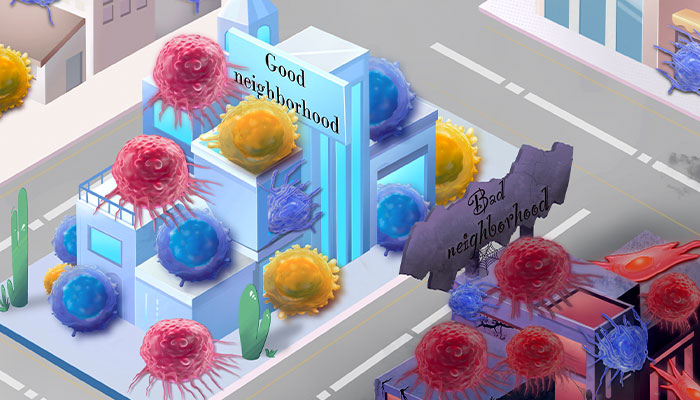HOW CAN WE HELP YOU? Call 1-800-TRY-CHOP
In This Section
Can an AI Deep-Learning Algorithm Determine How Cells Organize to Function in Tissue?

Tissue cellular neighborhoods describe the functional units in which different, recurrent groups of cells work together to support specific tissue functions. Image design: Qin Yan
The findings:
Children's Hospital of Philadelphia researchers and colleagues from several institutions developed a new artificial-intelligence (AI) deep-learning algorithm called CytoCommunity to better understand how different cells in tissue organize themselves to support tissue function, or in the case of tumor cells, communicate with each other to evade treatment. After analyzing risk-stratified data from the tissue cell neighborhoods (TCNs) of two different types of cancer tissues (colorectal and breast), the computational tool revealed new granulocyte-enriched and cancer-associated, fibroblast-enriched TCNs specific to high-risk tumors and altered interactions between neoplastic and immune or stromal cells within and between TCNs. CytoCommunity can perform unsupervised and supervised analyses of spatial omics maps and enable the discovery of condition-specific cell-cell communication patterns across spatial scales.
Why it matters:
Until recent advances in spatial omics technology, it was extremely difficult to characterize more than a dozen proteins or genes across a piece of tissue, which could be home to hundreds of thousands of cells and their respective genes. CytoCommunity helps researchers analyze the large amount of spatial omics data to provide a more comprehensive picture of the cell tissue microenvironment and phenotype behaviors. The tool also can perform supervised discovery on patient outcomes to determine the effects of one therapy in a TCN compared to another, providing insight as to why certain therapies may work better than others.
Who conducted the study:
Senior author Kai Tan, PhD, an investigator in the Center for Childhood Cancer Research at CHOP, led the study. Colleagues include Jacqueline Peng, MS and Jiazhen Rong, MS, from the graduate group in Genomics and Computational Biology in the Perelman School of Medicine at the University of Pennsylvania.
How they did it:
Researchers proposed the concept of TCNs to describe the functional units in which different, recurrent groups of cells work together to support specific tissue functions. The CytoCommunity deep-learning algorithm then translates the vast amount of spatial omics data in models and hypotheses that researchers can interpret.
The algorithm maps TCNs based on cell identities within a tissue sample, their spatial distributions, and patient clinical data using a deep neural network model. For this study, researchers used tissue samples from breast and colorectal tumors because the high volume of data available allowed them to train the algorithm to identify TCNs associated with high-risk disease subtypes.
Quick thoughts:
"It is very difficult to study the tissue microenvironment, how certain cells organize, behave, and communicate with one another," Dr. Tan said. "Since we were able to prove the effectiveness of CytoCommunity, the next step is to apply this algorithm to both healthy and diseased tissue data generated by individual labs and research consortia such as the Human BioMolecular Atlas Program and Human Tumor Atlas Network. We hope to find tissue cellular neighborhoods that might be associated with responses to certain therapies."
What's next:
Future studies should consider applying the CytoCommunity algorithm to both healthy and diseased tissue data. Mapping tumors from childhood cancers such as leukemia, neuroblastoma, and high-grade gliomas could help researchers determine which TCNs might be associated with responses to certain therapies. Combining those findings with genetic data could help determine which genetic pathways may be involved at the cellular and molecular levels that mediate how neighborhood cells interact.
Where the study was published:
The study appears in Nature Methods.


